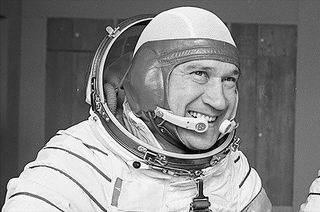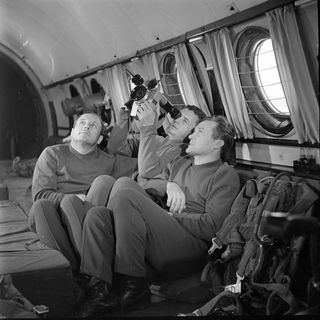Cosmonaut Anatoly Filipchenko, who led two docking flight tests, dies at 94
Filipchenko was the commander of Soyuz 7 and Soyuz 16.

Soviet-era cosmonaut Anatoly Filipchenko, who launched on two docking tests, first for a possible Russian moon landing and then the first joint flight with the United States, has died at the age of 94.
Filipchenko's death on Sunday (Aug. 7) was reported by Roscosmos, Russia's federal space corporation, and by the Gagarin Cosmonaut Training Center in Star City, outside of Moscow.
"Anatoly Vasilievich was a purposeful, demanding, diligent and fair person, always ready to help people. His life path was filled with honest service to the Motherland, creative work and devotion to the chosen cause," training center officials wrote in a statement. "The leadership and staff of the center, [as well as] the cosmonaut team express their sincere deepest condolences to all the relatives and friends of Anatoly Vasilyevich."
"The bright memory of Anatoly Vasilyevich Filipchenko will forever remain in our hearts," the center's statement read.
Related: The top 10 Soviet and Russian space missions
A member of the second group of Soviet Air Force pilots chosen to be cosmonauts in 1963, Filipchenko entered the corps along with 14 other trainees. He flew twice into space, first as the commander of Soyuz 7 in 1969, and then as commander of Soyuz 16 five years later.
On his first mission, Filipchenko and his crewmates, Vladislav Volkov and Viktor Gorbatko, were part of the first joint mission between three spacecraft. Launched on Oct. 12, 1969, the crew of Soyuz 7 lifted off on the same day as Soyuz 6 (crewed by Georgy Shonin and Valery Kubasov) and was followed into Earth orbit two days later by Soyuz 8 (Vladimir Shatalov and Aleksei Yeliseyev).
Get the Space.com Newsletter
Breaking space news, the latest updates on rocket launches, skywatching events and more!

Filipchenko and his Soyuz 7 crewmates were tasked with docking their spacecraft with Soyuz 8, repeating the feat that was first achieved by Soyuz 4 and Soyuz 5 in January 1969, while the Soyuz 6 crew filmed the link-up from nearby. The docking would have tested procedures and hardware needed for a Soviet moon landing — as already accomplished by the U.S. in July of that same year — but equipment failures prevented Soyuz 7 and Soyuz 8 from joining.
Filipchenko, Volkov and Gorbatko returned to Earth on Oct. 17, 1969, bringing to a close their country's attempt at a crewed lunar program.
Filipchenko returned to space on Dec. 2, 1974, as commander of Soyuz 16. Flying with Nikolai Rukavishnikov, the two were assigned to a different type of docking trial, testing hardware for what became the Apollo-Soyuz Test Project (ASTP) in July 1975.
During the six-day Soyuz 16 mission, Filipchenko and Rukavishnikov tested the androgynous docking system that would be used to connect the Soyuz with the American Apollo spacecraft. They extended and retracted a simulated docking ring, as well as tested emergency measures if the capture latches got stuck during the international mission.
Filipchenko and Rukavishnikov completed the Apollo-Soyuz rehearsal by testing a modified environmental system and a new radar docking system prior to landing.
In total, Filipchenko logged 10 days, 21 hours and 3 minutes on his two flights.
Anatoly Vasilyevich Filipchenko was born on Feb. 26, 1928, in Davydovka, an urban settlement in the Liskinsky District of the Voronezh Oblast in Russia. In 1950, he graduated as a military pilot from the Chuguev aviation school in Kharkiv, Ukraine. Filipchenko then studied at the Air Force Military Academy in Monino, Russia from 1957 to 1961.
From 1951 to 1960, Filipchenko served as a pilot, senior pilot, flight commander, squadron navigator-pilot-operator and deputy squadron commander in the 161st Fighter Aviation Regiment (based in the Leningrad Military District, then in Romania and the Odessa Military District). During this time, he flew multiple types of aircraft, logging over 1,500 hours in the UT-2, La-9, MiG-15, MiG-21, Su-7, Su-9, Su-11, Yak-11, Yak-18, Yak-25 (with modifications) and Yak-28.
He was serving as a senior instructor-pilot in the aviation division of the 48th Air Army of the Odessa Military District when, by order of the commander in chief of the Soviet Air Force, he was enrolled at the cosmonaut training center.
Related: Space race: Could the U.S. have beaten the Soviets into space?

In addition to his own spaceflights, Filipchenko served as the backup commander for Soyuz 5, Soyuz 9 and the Apollo-Soyuz Test Project in 1969, 1970 and 1975, respectively.
After his second and final mission, from 1978 to 1980, Filipchenko organized and served as the first president of the Federation of Cosmonautics of the USSR. He resigned from the cosmonaut corps in 1982 to become a department head at the Gagarin Cosmonaut Training Center.
In 1987, Filipchenko defended his dissertation in the field of military navigation at the Air Force Academy and received his doctorate in military sciences. A year later, he was dismissed from active military service and became a director at the Moscow branch of the Kharkov Experimental Design Bureau. He retired in 1993.
Twice named a Hero of the Soviet Union, Filipchenko was awarded two Orders of Lenin and the Order of the Red Banner of Labor, among many other medals for his service to the Soviet space program. He was also awarded the title of laureate of the State Prize of the USSR and the title of "Honorary Citizen" of the cities of Kaluga, Chita, Lipetsk, Ostrogozhsk, Davydovka, Karaganda, Arkalyk, Sumy and Houston, Texas.
Filipchenko was married twice, first to Yelitsaveta A. Kuzhalskaya, with whom he had two boys, Alexander and Igor, before wedding Vera P. Kienko-Lobanova.
A funeral service is being planned for a later date at the Federal Military Memorial Cemetery in Mytishchinsky, on the northeastern outskirts of Moscow.
Follow collectSPACE.com on Facebook and on Twitter at @collectSPACE. Copyright 2022 collectSPACE.com. All rights reserved.
Join our Space Forums to keep talking space on the latest missions, night sky and more! And if you have a news tip, correction or comment, let us know at: community@space.com.

Robert Pearlman is a space historian, journalist and the founder and editor of collectSPACE.com, an online publication and community devoted to space history with a particular focus on how and where space exploration intersects with pop culture. Pearlman is also a contributing writer for Space.com and co-author of "Space Stations: The Art, Science, and Reality of Working in Space” published by Smithsonian Books in 2018. He previously developed online content for the National Space Society and Apollo 11 moonwalker Buzz Aldrin, helped establish the space tourism company Space Adventures and currently serves on the History Committee of the American Astronautical Society, the advisory committee for The Mars Generation and leadership board of For All Moonkind. In 2009, he was inducted into the U.S. Space Camp Hall of Fame in Huntsville, Alabama. In 2021, he was honored by the American Astronautical Society with the Ordway Award for Sustained Excellence in Spaceflight History.

